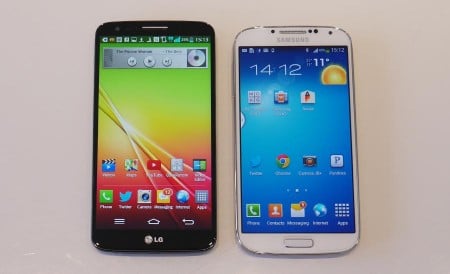There’s also a handy infrared port at the top of the smartphone, and while we’ve seen this sort of technology before on the HTC and Samsung smartphones for use with TV, LG has gone ahead and thrown in support for air conditioners, too.
We had trouble linking our G2 with either the Panasonic or Fujitsu air conditioner units in the GadgetGroup offices, but that’s not to say that support won’t be added later in a software patch.
There’s also the optional cover accessory, which protects the screen, but features a small window to the device, similar to what Samsung has done with its Galaxy S4 covers.
We haven’t tested what Samsung uses, but in the LG case, the small window activates a sort of light application that lets you flick between weather, the time, and the music app, allowing you to check out these functions without even opening the cover.

Let’s talk performance, though, because it’s an area where LG’s work on the G2 really pays off.
The system specifications are close to what Samsung has in the Note 3, with a similar Snapdragon 800 processor from Qualcomm, a quad-core chip clocked at 2.26GHz, paired with 2GB RAM, which is 1GB below what the Note 3 uses, but matched to Google’s Android sweet-spot, which is 2GB.
Benchmarks tests produce scores higher than most devices for this handset, but the real proof is in the operational speed, and there’s virtually no lag in anything here, even when you’re running multiple applications.
Mobile performance is equally impressive, and while we didn’t get a chance to try out the G2’s Time-Division LTE compatibility on the Optus network, we did see strong performances testing on Telstra’s 4G, resulting in transfer speeds as high as 97Mbps, which is much higher than the wired ADSL2+ connection back home.
The G2 is also a Cat4 LTE device, which means anyone with access to a compliant network could see speeds higher than the Cat3 limit of 100Mbps, with as much as 150Mbps capable from the Cat4.
In Australia and at the time of writing, this is available with Vodafone only, and means the G2 is essentially capable of some truly NBN-busting speeds, much like the Samsung Galaxy Note 3 and Sony Xperia Z1, which both support the Cat4 standard.
Battery performance is also quite impressive, with the 3000mAh non-replaceable battery offering as much as two days of life, though power users will probably see a day and a half.
We tested it twice just to make sure, and two days seemed consistent for us, running it between listening to audio through both streaming solutions and lossless FLAC audio, surfing the web, social networking, checking emails, taking photographs, making phone calls, and generally using the phone throughout the days.
Of likely help here is a quiet mode that switches off notifications when you’re sleeping, a factor that makes sense, but if you opt to use this, the two days of battery life is easily possible.















So this is the phone that rumours say the Nexus 5 will be based on? Pretty solid parent, especially if they add what it got wrong like more storage.
Happy with phone in most areas except battery – it only lasts me just over 12 hours.
Can not wait to get this phone. Here in the UK, just waiting for my NHS discount to come through and I will be getting a great deal. I don’t mind the 16Gb storage, I only use about 10Gb MAX. but usually only 8Gb. Also the battery is the best. The Samsung S4 battery only lasts 6/7 hours with the mobile data on. My friend unplugged hers at 8am and we met in town for a few hours. By the time it was 2pm the battery was in the orange zone and that was after turning mobile internet off. It has too much and can not handle it. But no complaints so far on the LG G2 from the 02 and carphone store my friend works at. No complaints or returns. But the Samsung has been returned lots due to poor battery and issues with it expanding when it gets hot and over heating issues. Obvious which is the safer option and most reliable option is the LG G2.